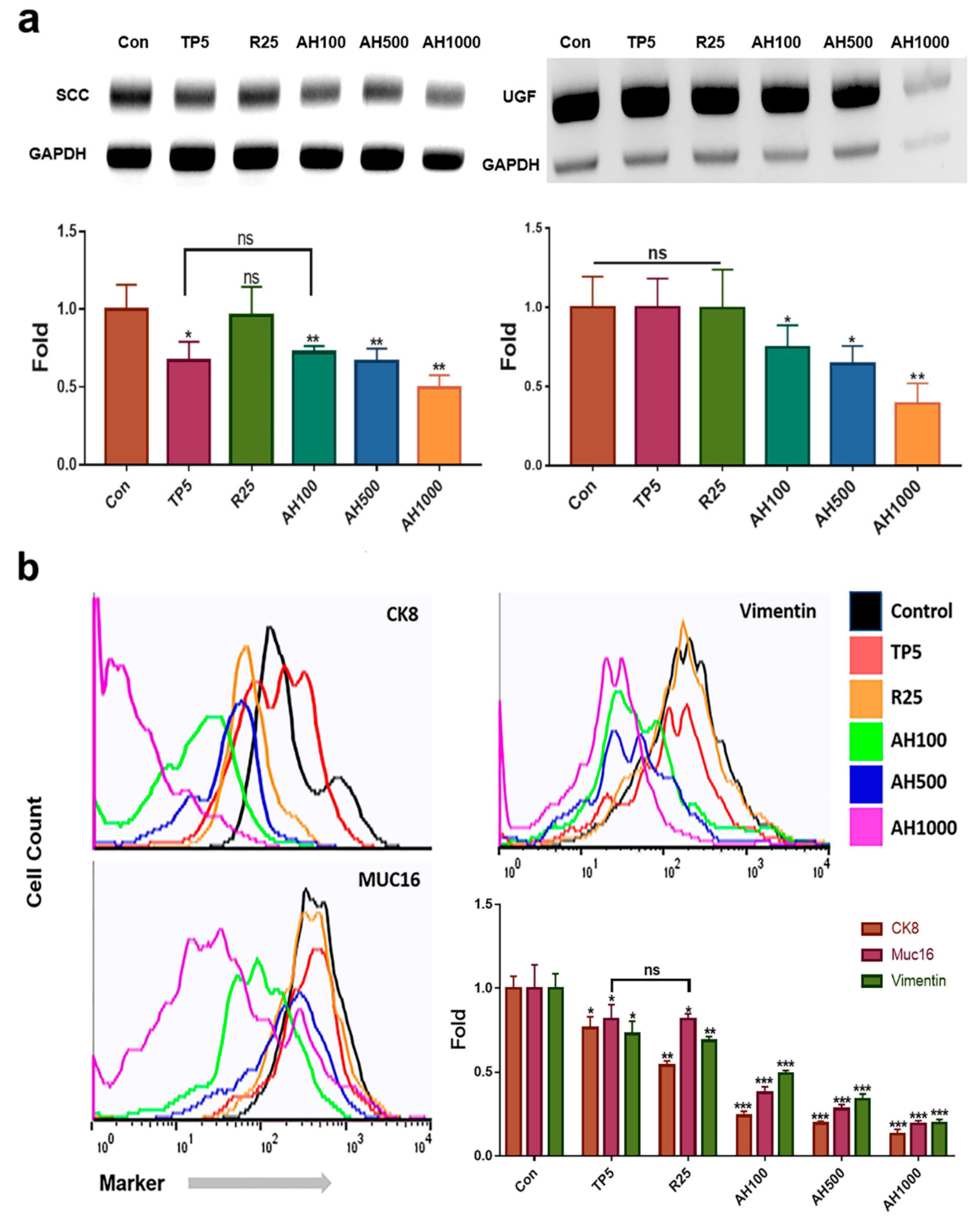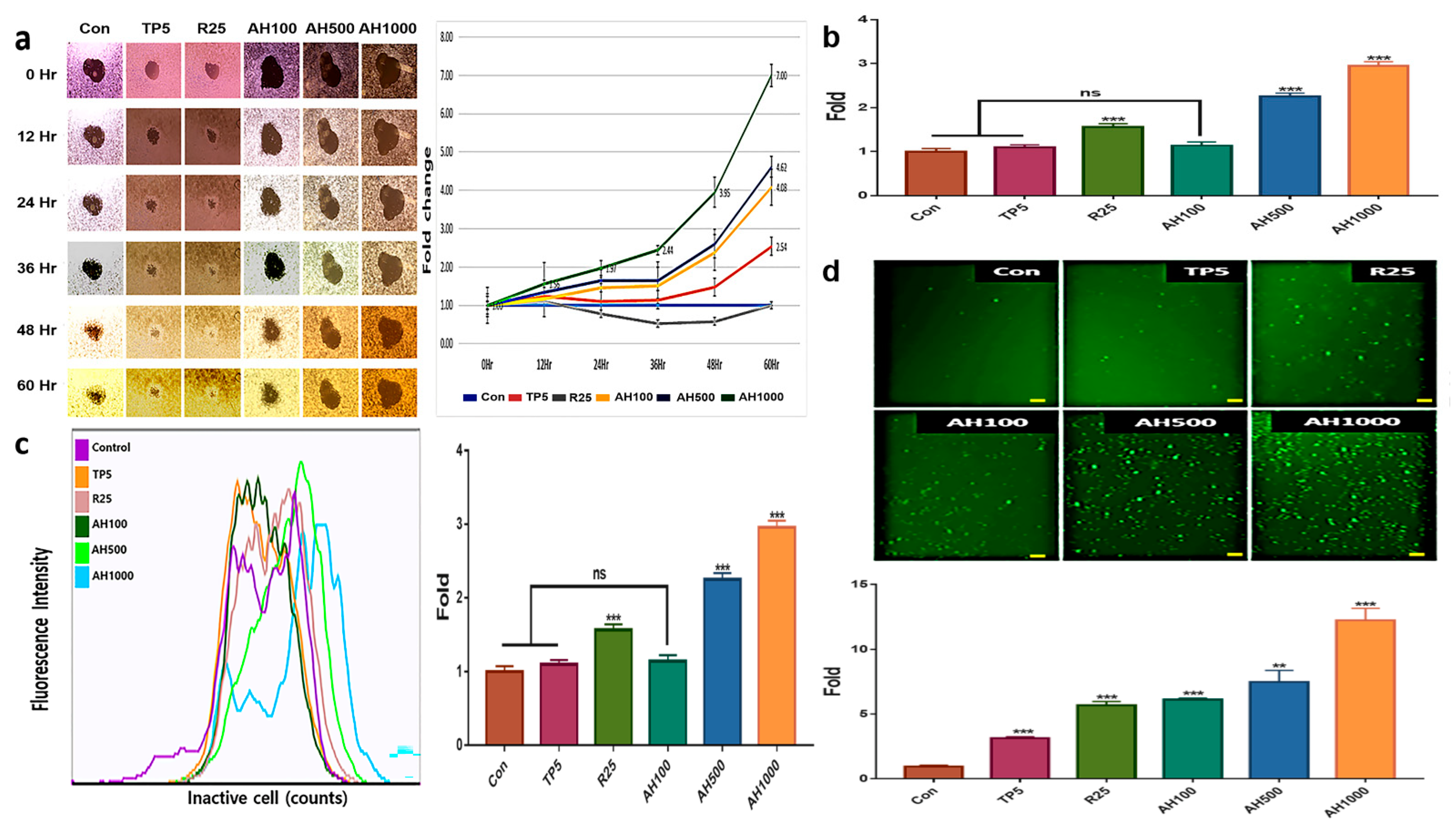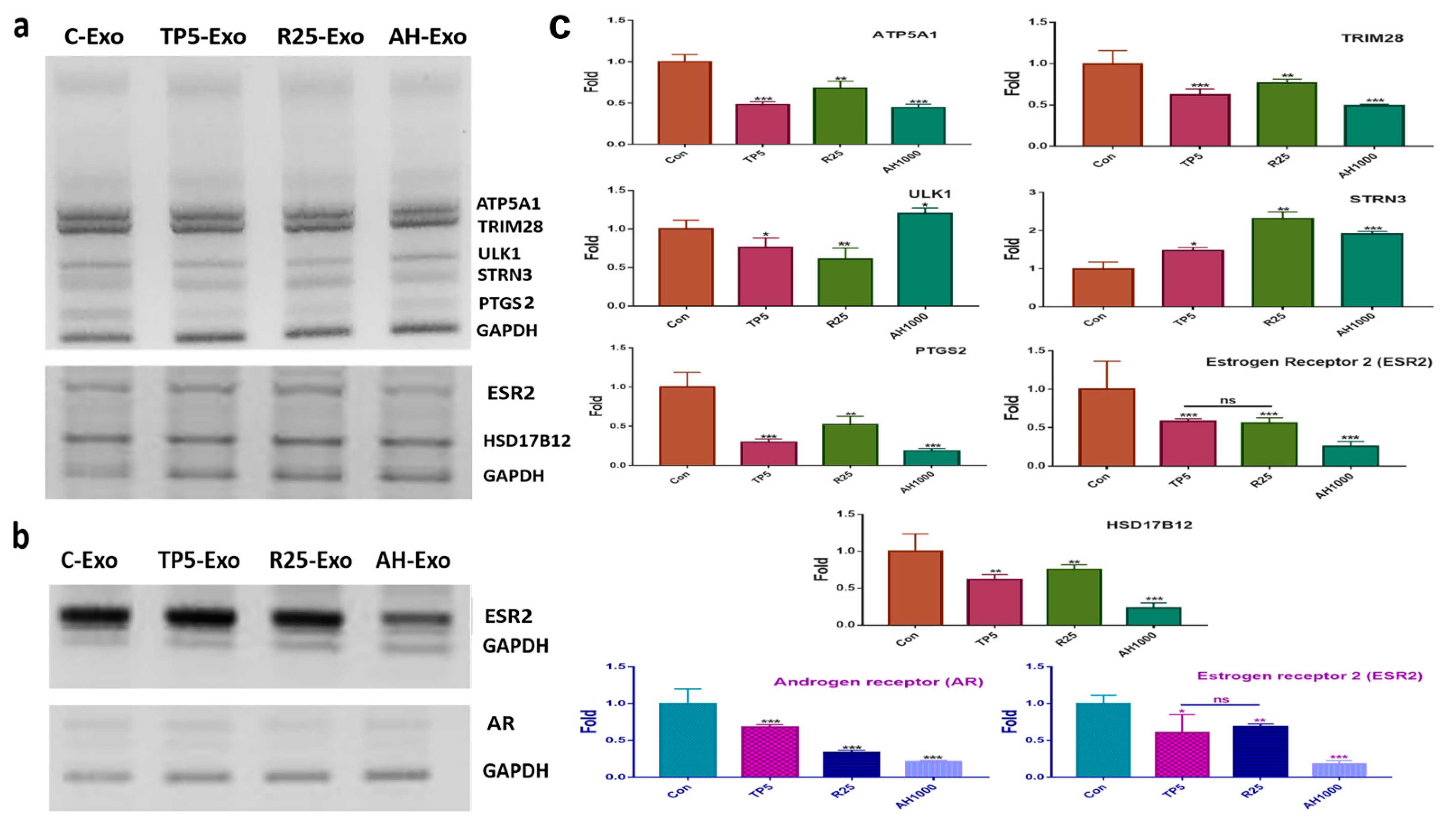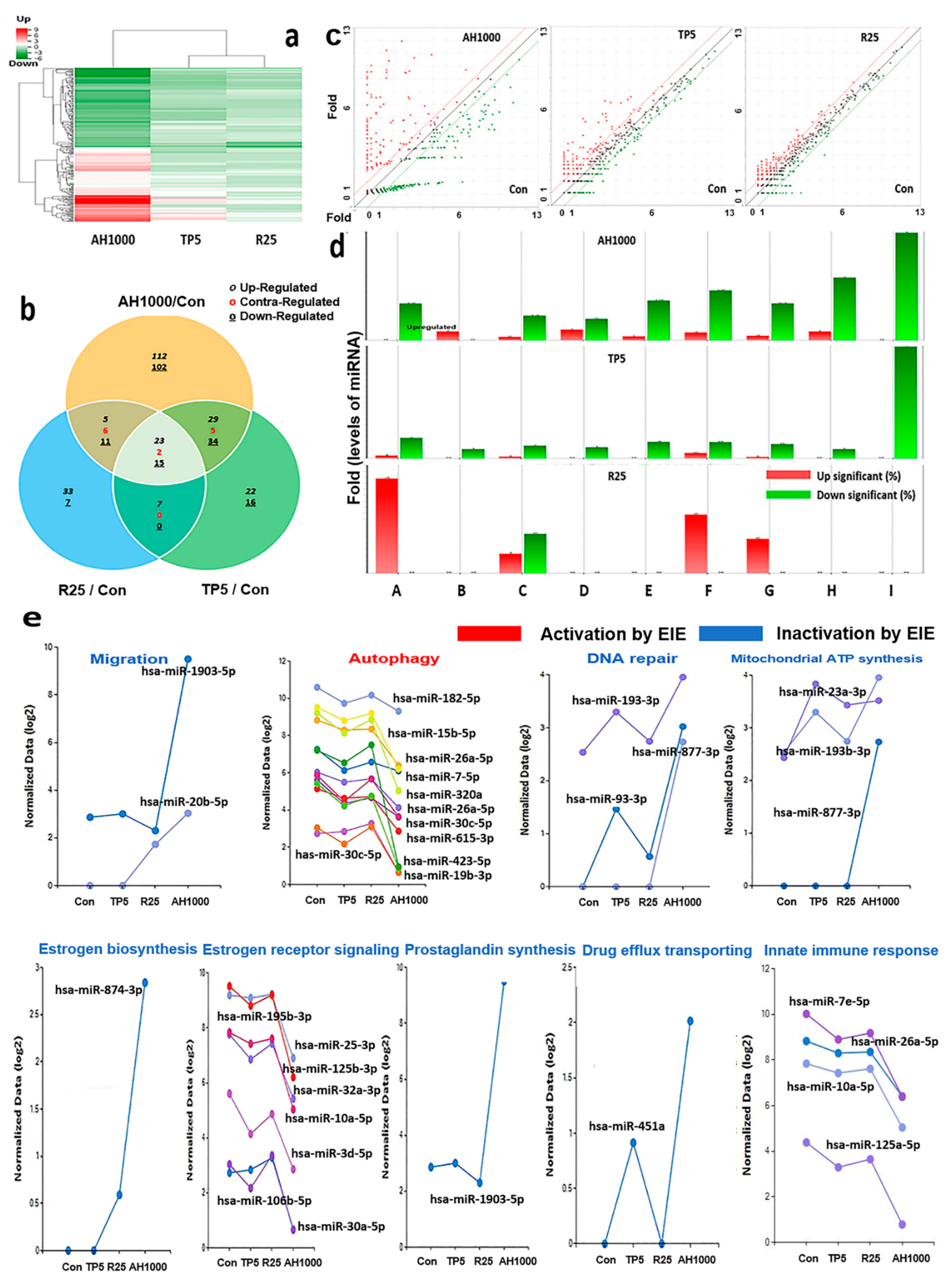Effects of Induced Exosomes from Endometrial Cancer Cells on Tumor Activity in the Presence of Aurea helianthus Extract
Abstract
:1. Introduction
2. Results
2.1. Expression of EC Cell Markers in the Presence of Bioactive Substances
2.2. Inhibition of Tumor Activity by Bioactive Substances
2.3. Expression of Cancerous Markers by the Induced Exosomes
2.4. Effects of Induced Exosomes
2.5. Profiling of miRNAs in the Induced Exosomes
3. Discussion
4. Materials and Methods
4.1. Cell Culture
4.2. Semi-Quantitative PCR
4.3. Flow Cytometry Analysis
4.4. Migration Test
4.5. Invasiveness Test
4.6. MMP Test
4.7. Senescence Test
4.8. Exosome Purification and miRNA Profiling
4.9. Statistical Analysis
5. Conclusions
Supplementary Materials
Author Contributions
Funding
Institutional Review Board Statement
Informed Consent Statement
Data Availability Statement
Acknowledgments
Conflicts of Interest
References
- Berstein, L.M.; Berlev, I.V.; Baltrukova, A.N. Endometrial cancer evolution: New molecular-biologic types and hormonal-metabolic shifts. Future Oncol. 2017, 13, 2593–2605. [Google Scholar] [CrossRef]
- Bharambe, B.M.; Deshpande, K.A.; Surase, S.G.; Ajmera, A.P. Malignant transformation of leiomyoma of uterus to leiomyosarcoma with metastasis to ovary. J. Obs. Gynaecol. India 2014, 64, 68–69. [Google Scholar] [CrossRef] [PubMed]
- Piura, E.; Piura, B. Brain metastases from endometrial carcinoma. ISRN Oncol. 2012, 2012, 581749. [Google Scholar] [CrossRef] [Green Version]
- Giatromanolaki, A.; Sivridis, E.; Papazoglou, D.; Koukourakis, M.I.; Maltezos, E. Human papillomavirus in endometrial adenocarcinomas: Infectious agent or a mere “passenger”? Infect. Dis. Obs. Gynecol. 2007, 2007, 60549. [Google Scholar] [CrossRef] [PubMed] [Green Version]
- Evans, T.; Sany, O.; Pearmain, P.; Ganesan, R.; Blann, A.; Sundar, S. Differential trends in the rising incidence of endometrial cancer by type: Data from a UK population-based registry from 1994 to 2006. Br. J. Cancer 2011, 104, 1505–1510. [Google Scholar] [CrossRef] [Green Version]
- Loomis, D.; Huang, W.; Chen, G. The International Agency for Research on Cancer (IARC) evaluation of the carcinogenicity of outdoor air pollution: Focus on China. Chin. J. Cancer 2014, 33, 189–196. [Google Scholar] [CrossRef]
- Hanahan, D.; Weinberg, R.A. The hallmarks of cancer. Cell 2000, 100, 57–70. [Google Scholar] [CrossRef] [Green Version]
- Meier, W.; Eiermann, W.; Stieber, P.; Schneider, A.; Fateh-Moghadam, A.; Hepp, H. Experiences with SCC antigen, a new tumor marker for cervical carcinoma. Eur. J. Cancer Clin. Oncol. 1989, 25, 1555–1559. [Google Scholar] [CrossRef]
- Gilles, C.; Polette, M.; Piette, J.; Delvigne, A.C.; Thompson, E.W.; Foidart, J.M.; Birembaut, P. Vimentin expression in cervical carcinomas: Association with invasive and migratory potential. J. Pathol. 1996, 180, 175–180. [Google Scholar] [CrossRef]
- Shen, H.; Guo, M.; Wang, L.; Cui, X. MUC16 facilitates cervical cancer progression via JAK2/STAT3 phosphorylation-mediated cyclooxygenase-2 expression. Genes Genom. 2020, 42, 127–133. [Google Scholar] [CrossRef]
- Nam, J.H.; Chang, K.C.; Chambers, J.T.; Schwartz, P.E.; Cole, L.A. Urinary gonadotropin fragment, a new tumor marker. III. Use in cervical and vulvar cancers. Gynecol. Oncol. 1990, 38, 66–70. [Google Scholar] [CrossRef]
- Steeg, P.S.; Theodorescu, D. Metastasis: A therapeutic target for cancer. Nat. Clin. Pract. Oncol. 2008, 5, 206–219. [Google Scholar] [CrossRef]
- Lopez-Romero, R.; Marrero-Rodriguez, D.; Romero-Morelos, P.; Villegas, V.; Valdivia, A.; Arreola, H.; Huerta-Padilla, V.; Salcedo, M. The role of developmental HOX genes in cervical cancer. Rev. Med. Inst. Mex. Seguro Soc. 2015, 53 (Suppl. S2), S188–S193. [Google Scholar] [PubMed]
- Bai, X.; Ma, Y.; Zhang, G. Butein suppresses cervical cancer growth through the PI3K/AKT/mTOR pathway. Oncol. Rep. 2015, 33, 3085–3092. [Google Scholar] [CrossRef] [PubMed] [Green Version]
- Hu, Y.F.; Lei, X.; Zhang, H.Y.; Ma, J.W.; Yang, W.W.; Chen, M.L.; Cui, J.; Zhao, H. Expressions and clinical significance of autophagy-related markers Beclin1, LC3, and EGFR in human cervical squamous cell carcinoma. Onco Targets Ther. 2015, 8, 2243–2249. [Google Scholar] [CrossRef] [Green Version]
- Cheng, Y.; Ma, D.; Zhang, Y.; Li, Z.; Geng, L. Cervical squamous cancer mRNA profiles reveal the key genes of metastasis and invasion. Eur. J. Gynaecol. Oncol. 2015, 36, 309–317. [Google Scholar]
- Biedka, M.; Makarewicz, R.; Marszalek, A.; Sir, J.; Kardymowicz, H.; Goralewska, A. Labeling of microvessel density, lymphatic vessel density and potential role of proangiogenic and lymphangiogenic factors as a predictive/prognostic factors after radiotherapy in patients with cervical cancer. Eur. J. Gynaecol. Oncol. 2012, 33, 399–405. [Google Scholar] [PubMed]
- Zhang, C.; Ji, Q.; Yang, Y.; Li, Q.; Wang, Z. Exosome: Function and Role in Cancer Metastasis and Drug Resistance. Technol. Cancer Res. Treat. 2018, 17. [Google Scholar] [CrossRef] [Green Version]
- Thery, C.; Zitvogel, L.; Amigorena, S. Exosomes: Composition, biogenesis and function. Nat. Rev. Immunol. 2002, 2, 569–579. [Google Scholar] [CrossRef]
- Park, Y.; Lee, K.; Lee, C.; Song, A.; Kim, J.; Kim, B.; Lee, S. Protection and immune modulation of activated human vaginal epithelial cells by Aurea helianthus extract. Sci. Rep. 2020, 10, 9227. [Google Scholar] [CrossRef]
- Das Gupta, S.; Suh, N. Tocopherols in cancer: An update. Mol. Nutr. Food Res. 2016, 60, 1354–1363. [Google Scholar] [CrossRef] [PubMed] [Green Version]
- Perk, A.A.; Shatynska-Mytsyk, I.; Gercek, Y.C.; Boztas, K.; Yazgan, M.; Fayyaz, S.; Farooqi, A.A. Rutin mediated targeting of signaling machinery in cancer cells. Cancer Cell Int. 2014, 14, 124. [Google Scholar] [CrossRef] [PubMed] [Green Version]
- Washington, C.R.; Haggerty, A.; Ronner, W.; Neff, P.M.; Ko, E.M. Knowledge of endometrial cancer risk factors in a general gynecologic population. Gynecol. Oncol. 2020, 158, 137–142. [Google Scholar] [CrossRef] [PubMed]
- Njoku, K.; Abiola, J.; Russell, J.; Crosbie, E.J. Endometrial cancer prevention in high-risk women. Best Pract. Res. Clin. Obs. Gynaecol. 2020, 65, 66–78. [Google Scholar] [CrossRef]
- Kajimura, T.; Sato, S.; Murakami, A.; Hayashi-Okada, M.; Nakashima, K.; Sueoka, K.; Sugino, N. Overexpression of carbonyl reductase 1 inhibits malignant behaviors and epithelial mesenchymal transition by suppressing TGF-beta signaling in uterine leiomyosarcoma cells. Oncol. Lett. 2019, 18, 1503–1512. [Google Scholar] [CrossRef] [Green Version]
- Suminami, Y.; Nagashima, S.; Vujanovic, N.L.; Hirabayashi, K.; Kato, H.; Whiteside, T.L. Inhibition of apoptosis in human tumour cells by the tumour-associated serpin, SCC antigen-1. Br. J. Cancer 2000, 82, 981–989. [Google Scholar] [CrossRef] [PubMed] [Green Version]
- Murakami, A.; Suminami, Y.; Hirakawa, H.; Nawata, S.; Numa, F.; Kato, H. Squamous cell carcinoma antigen suppresses radiation-induced cell death. Br. J. Cancer 2001, 84, 851–858. [Google Scholar] [CrossRef] [Green Version]
- Murakami, A.; Nakagawa, T.; Kaneko, M.; Nawata, S.; Takeda, O.; Kato, H.; Sugino, N. Suppression of SCC antigen promotes cancer cell invasion and migration through the decrease in E-cadherin expression. Int. J. Oncol. 2006, 29, 1231–1235. [Google Scholar] [CrossRef] [PubMed]
- Jankowska, A.; Gunderson, S.I.; Andrusiewicz, M.; Burczynska, B.; Szczerba, A.; Jarmolowski, A.; Nowak-Markwitz, E.; Warchol, J.B. Reduction of human chorionic gonadotropin beta subunit expression by modified U1 snRNA caused apoptosis in cervical cancer cells. Mol. Cancer 2008, 7, 26. [Google Scholar] [CrossRef] [Green Version]
- Wu, W.; Gao, H.; Li, X.; Peng, S.; Yu, J.; Liu, N.; Zhan, G.; Zhu, Y.; Wang, K.; Guo, X. β-hCG promotes epithelial ovarian cancer metastasis through ERK/MMP2 signaling pathway. Cell Cycle 2019, 18, 46–59. [Google Scholar] [CrossRef]
- Singh, P.; Sarkar, M.; Agrawal, U.; Huhtaniemi, I.; Pal, R. The transgenic expression of the β-subunit of human chorionic gonadotropin influences the growth of implanted tumor cells. Oncotarget 2018, 9, 34670. [Google Scholar] [CrossRef] [PubMed] [Green Version]
- Berman, R.; Steel, G. Induced and inherent resistance to alkylating agents in human small-cell bronchial carcinoma xenografts. Br. J. Cancer 1984, 49, 431–436. [Google Scholar] [CrossRef] [Green Version]
- Cabrera, S.; Llauradó, M.; Castellví, J.; Fernandez, Y.; Alameda, F.; Colás, E.; Ruiz, A.; Doll, A.; Schwartz, S.; Carreras, R. Generation and characterization of orthotopic murine models for endometrial cancer. Clin. Exp. Metastasis 2012, 29, 217–227. [Google Scholar] [CrossRef]
- Cheng, H.; Liu, P.; Zhang, F.; Xu, E.; Symonds, L.; Ohlson, C.E.; Bronson, R.T.; Maira, S.-M.; Di Tomaso, E.; Li, J. A genetic mouse model of invasive endometrial cancer driven by concurrent loss of Pten and Lkb1 Is highly responsive to mTOR inhibition. Cancer Res. 2014, 74, 15–23. [Google Scholar] [CrossRef] [Green Version]
- Fedorko, A.M.; Kim, T.H.; Broaddus, R.; Schmandt, R.; Chandramouli, G.V.; Im Kim, H.; Jeong, J.-W.; Risinger, J.I. An immune competent orthotopic model of endometrial cancer with metastasis. Heliyon 2020, 6, e04075. [Google Scholar] [CrossRef] [PubMed]
- Nagaraja, A.S.; Dorniak, P.L.; Sadaoui, N.C.; Kang, Y.; Lin, T.; Armaiz-Pena, G.; Wu, S.Y.; Rupaimoole, R.; Allen, J.K.; Gharpure, K.M.; et al. Sustained adrenergic signaling leads to increased metastasis in ovarian cancer via increased PGE2 synthesis. Oncogene 2016, 35, 2390–2397. [Google Scholar] [CrossRef] [PubMed] [Green Version]
- Morelli, M.P.; Brown, A.M.; Pitts, T.M.; Tentler, J.J.; Ciardiello, F.; Ryan, A.; Jürgensmeier, J.M.; Eckhardt, S.G. Targeting vascular endothelial growth factor receptor-1 and -3 with cediranib (AZD2171): Effects on migration and invasion of gastrointestinal cancer cell lines. Mol. Cancer Ther. 2009, 8, 2546–2558. [Google Scholar] [CrossRef] [Green Version]
- Mu, P.; Karuppasamy, R. Discovery of human autophagy initiation kinase ULK1 inhibitors by multi-directional in silico screening strategies. J. Recept. Signal Transduct. Res. 2019, 39, 122–133. [Google Scholar] [CrossRef]
- Xu, G.; Li, J.Y. ATP5A1 and ATP5B are highly expressed in glioblastoma tumor cells and endothelial cells of microvascular proliferation. J. Neuro Oncol. 2016, 126, 405–413. [Google Scholar] [CrossRef]
- Brüggemann, M.; Gromes, A.; Poss, M.; Schmidt, D.; Klümper, N.; Tolkach, Y.; Dietrich, D.; Kristiansen, G.; Müller, S.C.; Ellinger, J. Systematic analysis of the expression of the mitochondrial ATP Synthase (Complex V) subunits in clear cell renal cell carcinoma. Transl. Oncol. 2017, 10, 661–668. [Google Scholar] [CrossRef]
- Kemiläinen, H.; Adam, M.; Mäki-Jouppila, J.; Damdimopoulou, P.; Damdimopoulos, A.E.; Kere, J.; Hovatta, O.; Laajala, T.D.; Aittokallio, T.; Adamski, J. The hydroxysteroid (17β) dehydrogenase family gene HSD17B12 is involved in the prostaglandin synthesis pathway, the ovarian function, and regulation of fertility. Endocrinology 2016, 157, 3719–3730. [Google Scholar] [CrossRef] [PubMed] [Green Version]
- Tan, B.; Long, X.; Nakshatri, H.; Nephew, K.P.; Bigsby, R.M. Striatin-3γ inhibits estrogen receptor activity by recruiting a protein phosphatase. J. Mol. Endocrinol. 2008, 40, 199–210. [Google Scholar] [CrossRef] [PubMed] [Green Version]
- Kim, J.-W.; Akiyama, M.; Park, J.-H.; Lin, M.-L.; Shimo, A.; Ueki, T.; Daigo, Y.; Tsunoda, T.; Nishidate, T.; Nakamura, Y. Activation of an estrogen/estrogen receptor signaling by BIG3 through its inhibitory effect on nuclear transport of PHB2/REA in breast cancer. Nat. Preced. 2009, 1. [Google Scholar] [CrossRef]
- Gay, F.; Anglade, I.; Gong, Z.; Salbert, G. The LIM/Homeodomain Protein Islet-1 Modulates Estrogen Receptor Functions. Mol. Endocrinol. 2000, 14, 1627–1648. [Google Scholar] [CrossRef] [PubMed]
- Young, J.L.; Jazaeri, A.A.; Darus, C.J.; Modesitt, S.C. Cyclooxygenase-2 in cervical neoplasia: A review. Gynecol. Oncol. 2008, 109, 140–145. [Google Scholar] [CrossRef]
- Wagner, W.; Kania, K.D.; Blauz, A.; Ciszewski, W.M. The lactate receptor (HCAR1/GPR81) contributes to doxorubicin chemoresistance via ABCB1 transporter up-regulation in human cervical cancer HeLa cells. J. Physiol. Pharm. 2017, 68, 555–564. [Google Scholar]
- Goldsmith, M.E.; Gudas, J.M.; Schneider, E.; Cowan, K.H. Wild type p53 stimulates expression from the human multidrug resistance promoter in a p53-negative cell line. J. Biol. Chem. 1995, 270, 1894–1898. [Google Scholar] [CrossRef] [Green Version]
- Zhou, G.; Kuo, M.T. NF-kappaB-mediated induction of mdr1b expression by insulin in rat hepatoma cells. J. Biol. Chem. 1997, 272, 15174–15183. [Google Scholar] [CrossRef] [Green Version]
- Bargou, R.C.; Jurchott, K.; Wagener, C.; Bergmann, S.; Metzner, S.; Bommert, K.; Mapara, M.Y.; Winzer, K.J.; Dietel, M.; Dorken, B.; et al. Nuclear localization and increased levels of transcription factor YB-1 in primary human breast cancers are associated with intrinsic MDR1 gene expression. Nat. Med. 1997, 3, 447–450. [Google Scholar] [CrossRef]
- Salvatore, C.; Camarda, G.; Maggi, C.A.; Goso, C.; Manzini, S.; Binaschi, M. NF-κB activation contributes to anthracycline resistance pathway in human ovarian carcinoma cell line A2780. Int. J. Oncol. 2005, 27, 799–806. [Google Scholar]
- Butt, G.; Shahwar, D.; Qureshi, M.Z.; Attar, R.; Akram, M.; Birinci, Y.; Karatoprak, G.S.; Gasparri, M.L.; Farooqi, A.A. Role of mTORC1 and mTORC2 in Breast Cancer: Therapeutic Targeting of mTOR and Its Partners to Overcome Metastasis and Drug Resistance. In Breast Cancer Metastasis and Drug Resistance; Springer: Berlin/Heidelberg, Germany, 2019; pp. 283–292. [Google Scholar]
- Papademetrio, D.L.; Lompardía, S.L.; Simunovich, T.; Costantino, S.; Mihalez, C.Y.; Cavaliere, V.; Álvarez, É. Inhibition of survival pathways MAPK and NF-kB triggers apoptosis in pancreatic ductal adenocarcinoma cells via suppression of autophagy. Target. Oncol. 2016, 11, 183–195. [Google Scholar] [CrossRef] [PubMed]
- Vakana, E.; Sassano, A.; Platanias, L.C. Induction of autophagy by dual mTORC1-mTORC2 inhibition in BCR-ABL-expressing leukemic cells. Autophagy 2010, 6, 966–967. [Google Scholar] [CrossRef] [PubMed]
- Chiu, Y.-H.; MacMillan, J.B.; Chen, Z.J. RNA Polymerase III Detects Cytosolic DNA and Induces Type I Interferons through the RIG-I Pathway. Cell 2009, 138, 576–591. [Google Scholar] [CrossRef] [PubMed] [Green Version]
- Hahn, A.F.; Hartung, H.-P.; Dyck, P.J. Chronic Inflammatory Demyelinating Polyradiculoneuropathy. In Peripheral Neuropathy, 4th ed.; Dyck, P.J., Thomas, P.K., Eds.; W.B. Saunders: Philadelphia, PA, USA, 2005; Chapter 99; pp. 2221–2253. [Google Scholar] [CrossRef]





| Table | miRNA Symbol | Fold | Evaluating Gene * | |
|---|---|---|---|---|
| I | Positive regulation of cell migration involved in sprouting angiogenesis | hsa-miR-1908-5p | 100 | PTGS2 |
| hsa-miR-20b-5p | 8.2 | VEGFA | ||
| II | Positive regulation of autophagy | hsa-miR-423-5p | 100 | ULK1 |
| hsa-miR-19b-3p | 25 | PRKAA1 | ||
| hsa-miR-320a | 20 | ULK1 | ||
| Positive regulation of DNA repair | hsa-miR-93-3p | 8.1 | NPM1, OTUB1, PARP1, SMC1A, TRIM28 | |
| hsa-miR-877-3p | 6.7 | SUPT16H, TRIM28, HMGB1 | ||
| Mitochondrial ATP synthesis coupled proton transport | hsa-miR-877-3p | 6.7 | ATP5A1, ATP5I | |
| III | Estrogen biosynthetic process | hsa-miR-874-3p | 7.2 | HSD17B12 |
| Negative regulation of intracellular estrogen receptor signaling pathway | hsa-miR-125b-5p | 10 | STRN3 | |
| hsa-miR-10a-5p | 6.9 | PHB2 | ||
| hsa-let-7d-5p | 6.8 | ISL1 | ||
| Positive regulation of prostaglandin biosynthetic process | hsa-miR-1908-5p | 100 | PTGS2 | |
| IV | Drug transmembrane transport | hsa-miR-451a | 4 | ABCB1 |
| V | Regulation of innate immune response | hsa-let-7e-5p | 12.5 | POLR3D |
| Up regulation | Down regulation | |||
Publisher’s Note: MDPI stays neutral with regard to jurisdictional claims in published maps and institutional affiliations. |
© 2021 by the authors. Licensee MDPI, Basel, Switzerland. This article is an open access article distributed under the terms and conditions of the Creative Commons Attribution (CC BY) license (https://creativecommons.org/licenses/by/4.0/).
Share and Cite
Park, Y.; Lee, K.; Kim, S.W.; Lee, M.W.; Kim, B.; Lee, S.G. Effects of Induced Exosomes from Endometrial Cancer Cells on Tumor Activity in the Presence of Aurea helianthus Extract. Molecules 2021, 26, 2207. https://doi.org/10.3390/molecules26082207
Park Y, Lee K, Kim SW, Lee MW, Kim B, Lee SG. Effects of Induced Exosomes from Endometrial Cancer Cells on Tumor Activity in the Presence of Aurea helianthus Extract. Molecules. 2021; 26(8):2207. https://doi.org/10.3390/molecules26082207
Chicago/Turabian StylePark, Yoonjin, Kyunghwa Lee, Suhng Wook Kim, Min Woo Lee, Boyong Kim, and Seung Gwan Lee. 2021. "Effects of Induced Exosomes from Endometrial Cancer Cells on Tumor Activity in the Presence of Aurea helianthus Extract" Molecules 26, no. 8: 2207. https://doi.org/10.3390/molecules26082207







